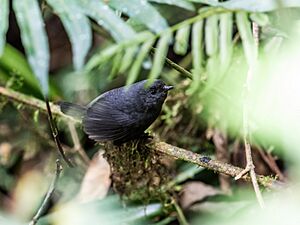Trilling tapaculo facts for kids
Quick facts for kids Trilling tapaculo |
|
|---|---|
 |
|
| Conservation status | |
| Scientific classification | |
| Genus: |
Scytalopus
|
| Species: |
parvirostris
|
 |
|
The trilling tapaculo (Scytalopus parvirostris) is a small bird known for its special song. It belongs to a bird family called Rhinocryptidae, which are often found in South America. You can find this bird living in the countries of Bolivia and Peru.
Contents
About the Trilling Tapaculo
Scientists group living things into categories. This helps them understand how different species are related. The trilling tapaculo was once thought to be the same as another bird, the unicolored tapaculo. But scientists listened closely to their songs. They found that the trilling tapaculo's song was very different. Because of this, it was given its own species name.
Even though it's now its own species, there are still small differences in the songs of trilling tapaculos depending on where they live. This makes scientists wonder if there might be even more types of trilling tapaculos that haven't been officially named yet.
What Does It Look Like?
The trilling tapaculo is a small bird, about 10.5 cm (4.1 in) long. That's about the length of a pen!
- Male birds usually weigh between 17.5 to 21 g (0.62 to 0.74 oz).
- Female birds are a little lighter, weighing 15.4 to 18 g (0.54 to 0.63 oz).
Adult males are mostly dark gray on their backs and a lighter gray on their bellies. Sometimes, they can be dark gray all over. The sides of their bodies and the feathers around their tail are a reddish-brown color with some darker stripes.
Female trilling tapaculos look similar to the males but are usually a bit paler. Young trilling tapaculos, called juveniles, look like the females. They also have a scaly look because the edges of their feathers are yellowish.
Where It Lives and Its Home
The trilling tapaculo lives on the eastern side of the Andes Mountains. You can find them from southern Amazonas in Peru, all the way southeast to western Santa Cruz in Bolivia.
These birds like to live in the thick plants and bushes found in humid montane forests. These are forests that grow on the sides of mountains.
- In Peru, they live at heights between 1,800 and 2,500 m (5,900 and 8,200 ft) above sea level.
- In Bolivia, they are found even higher, from 2,000 to 3,200 m (6,600 to 10,500 ft), and sometimes even up to 3,300 m (10,800 ft).
Trilling Tapaculo Behavior
How It Finds Food
The trilling tapaculo searches for food in the dense plants close to the ground. It usually looks for food alone or sometimes with another bird. Scientists don't know exactly what this bird eats yet. They are still studying its diet.
Reproduction and Nests
For a long time, not much was known about how trilling tapaculos raise their young. We only knew that a young bird was found in July.
Then, in 2009, some researchers made an exciting discovery in Peru. They found a trilling tapaculo nest!
- The nest was shaped like a ball.
- It was made mostly of small roots on the outside.
- The inside was soft, lined with fern scales.
- The birds built this cozy nest inside a hole in a rotten tree.
- The nest held two eggs.
The researchers watched the nest to see the eggs hatch. The eggs hatched seven days after they were found. Sadly, the baby birds, called nestlings, disappeared soon after. They were too young to fly away, so the scientists think another animal might have eaten them.
Its Special Song
The trilling tapaculo gets its name from its song, which sounds like a fast trill! The speed of this trill changes depending on where the bird lives:
- In central Peru, the trill has about 21 notes per second [1].
- In southern Peru, it's a bit slower, with 14 notes per second [2].
- In Bolivia, the trill is very fast, with 20 to 28 notes per second [3].
The trilling tapaculo also has a "scold" call, which is similar to its song but shorter [4]. It also makes a simple single-note call [5].
Conservation Status
The IUCN (International Union for Conservation of Nature) is an organization that checks on the health of animal populations. They have said that the trilling tapaculo is a species of "Least Concern." This means that it is not currently in danger of disappearing.
The bird lives across a large area, and even though we don't know the exact number of trilling tapaculos, scientists believe there are many of them. Their population seems to be stable, which is good news for this unique bird.


